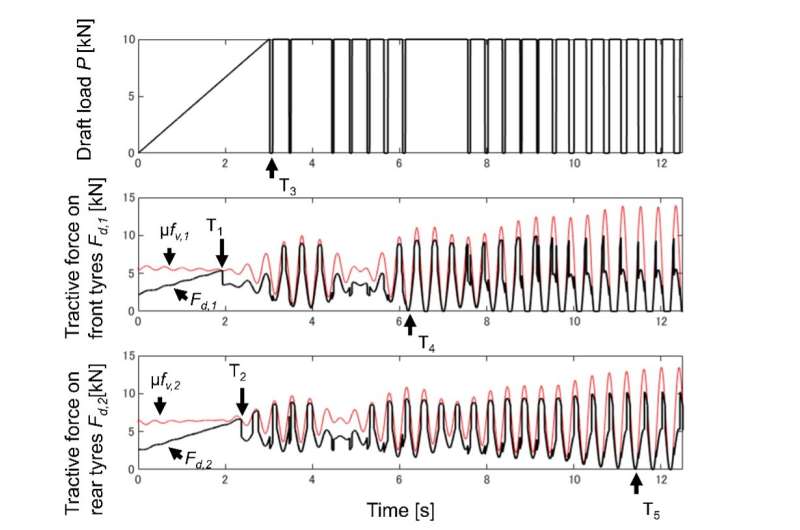

Modeling dynamic instability in tractors
source link: https://techxplore.com/news/2021-05-dynamic-instability-tractors.html
Go to the source link to view the article. You can view the picture content, updated content and better typesetting reading experience. If the link is broken, please click the button below to view the snapshot at that time.
May 4, 2021
Modeling dynamic instability in tractors
by Tokyo University of Agriculture and Technology
 Top: Draft load P [kN]: Middle: Tractive force acting on the front wheel Fd,1 [kN] and static friction limitation of the front tyres μfv,1 [kN]; Bottom: Tractive force acting on the front tyres Fd,2 [kN] and static friction limitation of the front tyres μfv,2 [kN]. Credit: Figure adapted with permission from Biosystems Engineering, Volume 204, 2021, Pages 156-169. © 2021 Published by Elsevier Ltd on behalf of IAgrE.
Top: Draft load P [kN]: Middle: Tractive force acting on the front wheel Fd,1 [kN] and static friction limitation of the front tyres μfv,1 [kN]; Bottom: Tractive force acting on the front tyres Fd,2 [kN] and static friction limitation of the front tyres μfv,2 [kN]. Credit: Figure adapted with permission from Biosystems Engineering, Volume 204, 2021, Pages 156-169. © 2021 Published by Elsevier Ltd on behalf of IAgrE.
Researchers at Tokyo University of Agriculture and Technology (TUAT) modeled the dynamic instability—the so-called 'power hop'—that can cause uncontrollable bouncing and damage tractors when they plow dry ground. The team found that self-excited oscillations can arise when the tractor pushes against the ground.
Plowing a field on a tractor may seem like a serene occupation, but sudden vibrations can grow unexpectedly and threaten to topple you under certain conditions. The problem is that in nonlinear systems with coupled components, as with a mechanical tractor, small shakes can grow exponentially until they become large oscillations. For tractors, this is called a 'power hop.' To better understand this potentially hazardous situation, researchers at TUAT simulated equations corresponding to the vertical, longitudinal, and pitching motion of the tractor.
"Our model reflects dynamics such as bouncing, stick-slip friction, and free-play, which were missing from some previous attempts to model this complex system," first author Masahisa Watanabe says. The equations were simulated using the fourth-order Runge-Kutta method on a millisecond scale.
In the numerical simulation using the developed model, power hop occurrence mechanism was described in the following figure.
In the simulation, draft load draft load P was increased from 0 to 10 kN. As the draft load increased, the tractive force on the front and rear tires also increased. At the point T1, the front tractive forces reached the limitation of the static friction μfv,1 and there was stick-slip oscillation. This oscillation leads to variation of the vertical loads and tractive forces. This variation in the vertical load acting on the rear tires caused the stick slip dynamics of the rear tires at the point T2. When the oscillation became severe, the tractive forces reduced and there was free play at the point T3. Vertical loads acting on the front and rear tires became zero and the front and rear tires lost contact with the ground at points T4 and T5 respectively.
This approach allowed the researchers to construct bifurcation diagrams showing regions of stability and when power hop dynamics began. The model showed that power hop can occur based on the drawbar pull, soil, and tire conditions.
The highest risk of power hop involved situations with high-draft loads on dry soil. That is, a dangerous feedback loop started during bouncing, leading to complete loss of traction with the ground. The model was even able to explain why this instability is much more likely to occur in four-wheel drive tractors. "The results we obtained agree with conventional wisdom from farmers about power hops, as well as with previous experiments," senior author Kenshi Sakai says. Nonlinear coupling between moving parts can happen in many industrial settings, and understanding how to avoid chaotic dynamics or uncontrolled vibrations can lead to safer factories and farms.
Explore further
Recommend
About Joyk
Aggregate valuable and interesting links.
Joyk means Joy of geeK